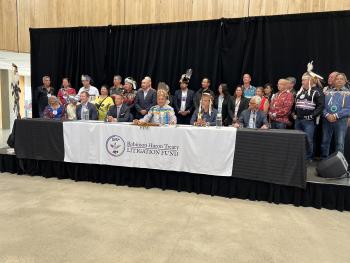Image Caption
Summary
Local Journalism Initiative Reporter
Windspeaker.com
In what was called a “step forward,” First Nations leadership and ministers for Canada and Ontario announced Saturday, June 17, that an out-of-court settlement had been reached in 1850 Robinson Huron Treaty annuities litigation.
The proposed settlement will see $10 billion covering past annuities paid to the 21 Robinson Huron First Nations in northern Ontario. The federal and provincial governments will split the bill evenly.
The settlement that is now under consideration by the treaty members is the result of legal action undertaken by the Robinson Huron First Nations in 2014 relating to Treaty annuities.
Annuities had been increased only once from the approximately $1.70 per person to $4 per person in 1875.
In 2018, the Ontario Superior Court found that the Crown was obligated to increase the annuities provided under the Robinson Treaties to reflect the net revenue the Crown receives from resources harvested in the Treaty territory.
“It’s the commencement of a larger agenda,” said Chief Dean Sayers of the Batchewana First Nation.
Sayers was joined by spokesperson Duke Peltier of the Wiikwemkoong Unceded Territory, Crown–Indigenous Relations Minister Marc Miller and Ontario Indigenous Affairs Minister Greg Rickford at the Laurentian University in Sudbury.
“The treaty provides a framework for peaceful coexistence and sharing of resources. Today we are glad to be able to take a step forward towards implementing that framework,” said Peltier.
“We see the proposed settlement as an opportunity for both Canada and Ontario to respect and implement our rights, as they've been affirmed in the treaty.”
Over the next six to eight months, consultations will take place with First Nations members, led by retired Ontario Court of Appeal judge Harry LaForme, an Anishinabe from the Mississaugas of the New Credit First Nation.
LaForme will prepare a report of recommendations for chiefs and trustees on how the settlement could be implemented in the communities.
The settlement includes individual payments, as well as community payments.
The federal and provincial governments will also complete their own internal processes to seek approval for signing the proposed settlement.
Finally, the Ontario Superiour Court must sign off on the settlement.
“This settlement is just the first step on the path of reconciliation. The proposed settlement agreement only deals with past compensation,” said Sayers. “This settlement is extremely significant, but we still have a long way to go. We still need to negotiate the implementation of the augmentation promise going forward.”
The augmentation clause obligates the Crown to increase the annuity.
Rickford said Ontario was “fully committed…to emphasize, as part of our commitment to reconciliation, negotiated settlements in all aspects of this.”
David Nahwegahbow, legal counsel for the Robinson Huron Treaty Litigation Fund, said that part of the proposed settlement is to suspend further litigation.
“There is the matter of the go-forward implementation of the augmentation promise, which we will be hopefully negotiating. There is a commitment expressed at this point, (which is) a non-binding legal commitment, a political commitment, to engage in those go-forward negotiations,” said Nahwegahbow, partner at Nahwegahbow Corbiere.
“It’s our people that have carried the burden of treaty for far too long. And this compensation from this settlement will ensure a stronger and brighter future for our people and our nations. The promise of the Robinson Huron Treaty was for a good life and flourishing communities,” said Peltier.
Miller said the annuity settlement was “unfinished business.”
“It is about governments paying the bills that have been long past due,” he said.
Miller said the 1850 treaty was intended to be the sharing of the land, resources and the revenues from those resources, but the Crown did not abide by those obligations.
He called the $10 billion that would flow to the Huron Robinson First Nations communities “a game changer.”
Local Journalism Initiative Reporters are supported by a financial contribution made by the Government of Canada.

